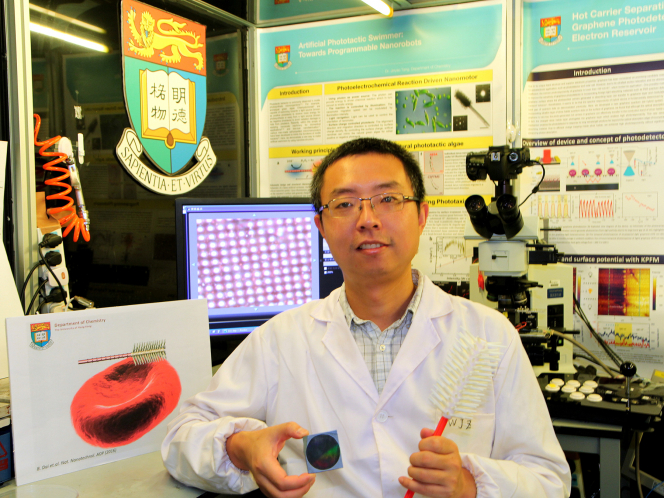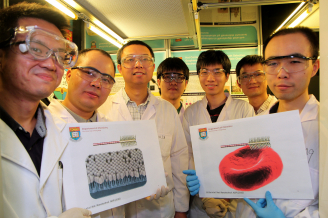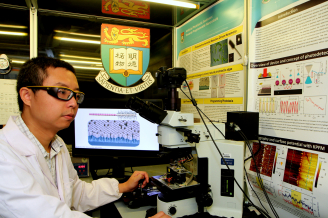Media
HKU chemists develop world’s first light-seeking synthetic Nanorobot
for potential biomedical applications
24 Oct 2016
A team of researchers led by Dr Jinyao Tang of the Department of Chemistry, the University of Hong Kong, has developed the world’s first light-seeking synthetic Nano robot. With size comparable to a blood cell, those tiny robots have the potential to be injected into patients’ bodies, helping surgeons to remove tumors and enabling more precise engineering of targeted medications. The findings have been published in October earlier in leading scientific journal Nature Nanotechnology.
It has been a dream in science fiction for decades that tiny robots can fundamentally change our daily life. The famous science fiction movie “Fantastic Voyage” is a very good example, with a group of scientists driving their miniaturized Nano-submarine inside human body to repair a damaged brain. In the film “Terminator 2”, billions of Nanorobots were assembled into the amazing shapeshifting body: the T-1000. In the real world, it is quite challenging to make and design a sophisticated Nano robot with advanced functions.
The Nobel Prize in Chemistry 2016 was awarded to three scientists for “the design and synthesis of molecular machines”. They developed a set of mechanical components at molecular scale which may be assembled into more complicated Nano machines to manipulate single molecule such as DNA or proteins in the future. The development of tiny nanoscale machines for biomedical applications has been a major trend of scientific research in recent years. Any breakthroughs will potentially open the door to new knowledge and treatments of diseases and development of new drugs.
One difficulty in Nanorobot design is to make these nanostructures sense and respond to the environment. Given each Nanorobot is only a few micrometer in size which is ~50 times smaller than the diameter of a human hair, it is very difficult to squeeze normal electronic sensors and circuits into Nanorobots with reasonable price. Currently, the only method to remotely control Nanorobots is to incorporate tiny magnetic inside the Nanorobot and guide the motion via external magnetic field.
The Nanorobot developed by Dr Tang’s team use light as the propelling force, and is the first research team globally to explore the light-guided Nanorobot and demonstrate its feasibility and effectiveness. In their paper published in Nature Nanotechnology, Dr Tang’s team demonstrated the unprecedented ability of these light-controlled Nanorobots as they are “dancing” or even spell a word under light control. With a novel Nanotree structure, the Nanorobots can respond to the light shining on it like moths being drawn to flames. Dr Tang described the motions as if “they can “see” the light and drive itself towards it”.
The team gained inspiration from natural green algae for the Nanorobot design. In nature, some green algae have evolved with the ability of sensing light around it. Even just a single cell, these green algae can sense the intensity of light and swim towards the light source for photosynthesis. Dr Jinyao Tang’s team spent three years to successfully develop the Nanorobots. With a novel Nanotree structure, they are composed of two common and low-price semiconductor materials: silicon and titanium oxide. During the synthesis, silicon and titanium oxide are shaped into nanowire and then further arranged into a tiny Nanotree heterostructure.
Dr Tang said: “Although the current Nanorobot cannot be used for disease treatment yet, we are working on the next generation nanorobotic system which is more efficient and biocompatible.”
“Light is a more effective option to communicate between microscopic world and macroscopic world. We can conceive that more complicated instructions can be sent to Nanorobots which provide scientists with a new tool to further develop more functions into Nanorobot and get us one step closer to daily life applications,” he added.
Abstract of journal article “Programmable artificial phototactic microswimmer”
http://www.nature.com/nnano/journal/vaop/ncurrent/full/nnano.2016.187.html
Image download and illustration:
http://www.scifac.hku.hk/news/media?page=1
For media enquiries, please contact Ms Cindy Chan, Senior Communication Manager of HKU Faculty of Science (tel: 3917 5286/ 6703 0212; email: cindycst@hku.hk ).



